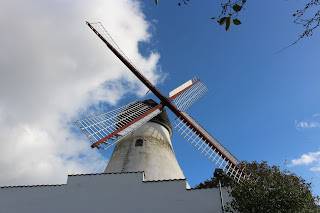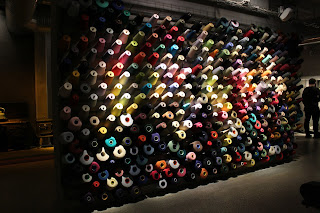 |
| Vejle windmill |
Vejle is from the Old Danish meaning ford. During the last ice age, a glacier carved out the fjord and the valley in which Vejle is found. The valley holds the Vejle river across which the Vikings built the short-lived Ravning Bridge - a 760 metre oak bridge which held the record for Denmark's longest bridge until 1935. People have been living in this area at least since 1100, although the bridge has been dated from as little as 980. During the middle ages Vejle was a market town mostly trading with present-day Germany, and it wasn't until industrialisation that Vejle really came into its own and entered a boom.
We made our way down the steep slope to the town's large art museum. There had been plenty of investment in the area, with a new local park that many people were enjoying under the blue October skies, art installations around the museum and the uncovering and cleanup of the underground Grejs river which formed newly created pretty canals across the whole town. The Vejle Art Museum had three stand out exhibits: an exhibition of 50 Rembrandts, artwork from the Danish Golden Age, and a temporary exhibit dedicated to satirists and satirical cartoons. The cartoon exhibit dealt with many historical events, but the large focus was on Syria, Trump and Brexit.
A new exhibit at the cultural center (whilst construction work went on in its traditional home of St. Nicolai Church) was the Haraldskaer woman. A so-called "bog-body", this female corpse was found in a bog in Jutland. Possibly strangled, she was found naked, although a leather cloak and some other possessions were found alongside her. Scans showed a preserved tongue, brain and intestines, and tests showed she came from Northern Jutland circa 490 BCE. In a poll taken by the museum the majority of participatns said they believed the woman had been sacrificed. No-one really knows what happened though - murder seems likely. This was one of the best preserved bog bodies found in Europe. Others had been destroyed by the action of uncovering them, and even the Haraldskaer woman lost her hair when they pulled her out. Archaeologists have better techniques to deal with these bodies now. and they are a fascinating piece of iron age history.
The final exhibit held numerous priceless ancient artefacts, mostly from from the Viking-era, although some artefacts dated back to Roman times. At the back of the centre we found a huge workshop space for artists and craftspeople jam-packed with very diverse pieces.
 |
| Colin with stuffed jackets and burgers |
Dystopia is slightly outside of town so we took a cab. We arrived nervously. The event we were going to was a scary Halloween "extreme" experience, and the waiver we had to sign told us we would be manhandled, we should be in good physical and mental condition and that our clothes would likely be ruined. They were not lying.
Men dressed up as armed guards greeted our taxi, but as our taxi driver was unaware of what the event entailed she stepped on the gas and quickly sped past. We tried explaining what was happening to her, but she just kept muttering "stupid people, stupid people" under her breathe - she was a proper old battleaxe.
 |
| Us being attacked at Dystopia haunted house |
 |
| Us finally leaving the Dystopia haunted house |
The next day, the 1st November 2018, we had a long lie in after a hard week of work, early morning flight, and all the craziness from the previous day. We decided to go sight-seeing in the morning, so we first headed across the road to look at an old kiln that was enclosed in a new protective building. The kiln probably dates back to 1355 when a Dominican friary was built on the site and it was used to make monk's bricks. The site was excavated in 1923 which has revealed that three successive kilns were built on the site over the centuries.
A quick interlude in the big shopping mall rewarded us with some wienerbrod - this is similar to what we would know as a Danish. There are many different types though - with custard, jam, icing - donut shapes, bun shapes and even a biscuit sandwich. Deliciously sugary.
One of the things we missed by the church being out of action was the 23 alcoves that contained 23 skulls. Legend said that these skulls belonged to Polish robbers who were executed and put on display as a deterrent, but no-one really knew who the heads belonged to.
Next up was a visit to the Ecolarium; a science museum dedicated to sustainability. A recent fire had closed part of the museum, and to their credit the museum had dedicated an exhibition to the fire, showcasing some of the damaged objects and showing pictures of the ones that were irretrievably lost. Documentation and the digitisation of all artefacts should be the duty of any good museum.
Upstairs there were interactive experiments and interesting information boards about energy and climate change. Denmark has been suffering lots of flooding in recent years, and with higher water levels and temperatures, this trend looked set to continue.
A piece on the origin of oil and coal was very interesting - plant residue drifted down into the lakes and transformed into peat, and then brown coal. The pressure over time turns the brown coal into normal coal and then hard coal (anthracite). In the sea a similar thing would happen but with organism waste turning into oil.
In 1985 protestors ended the usage of nuclear power in Denmark, even though it was in Danish Greenland that uranium was first discovered in 1956. A Danish physicist called Niels Bohr was the chief scientist. In recent times there has been a growing movement by Danish scientists to reverse public opinion on nuclear, and to start using thorium in new nuclear reactors. Thorium has a smaller half-life than uranium, and the newer reactors use liquid salt reactors which do not melt down (think Chernobyl).
After the musuem we walked through the rest of the town to the harbour and the fjord. There was some really nice architecture in the docks, including the Fjordenhus and the Bolgen (the Wave). These award-winning buildings are now Vejle landmarks just as much as the ever-present iconic windmill.
In the church grounds were two large runestones, one raised by King Gorm and the other by his son King Harald Bluetooth. King Gorm was Denmark's first recognised ruler, most probably only of the mainland called Jutland, and he created the smaller (and older) of the two runestones. This runestone is a memorial to Gorm's wife, has the first mention of the country of Denmark, and is therefore considered Denmark's birth certificate. The second and larger runestone was created by Harald Bluetooth and speaks to the unification of Denmark and Norway under Harald Bluetooth into one Christian country. Christ is clearly depicted on the runestone, with the declaration that all Danes are now Christian.
| ᚼᛅᚱᛅᛚᛏᚱ ᛬ ᚴᚢᚾᚢᚴᛦ ᛬ ᛒᛅᚦ ᛬ ᚴᛅᚢᚱᚢᛅ ᚴᚢᛒᛚ ᛬ ᚦᛅᚢᛋᛁ ᛬ ᛅᚠᛏ ᛬ ᚴᚢᚱᛘ ᚠᛅᚦᚢᚱ ᛋᛁᚾ ᛅᚢᚴ ᛅᚠᛏ ᛬ ᚦᚭᚢᚱᚢᛁ ᛬ ᛘᚢᚦᚢᚱ ᛬ ᛋᛁᚾᛅ ᛬ ᛋᛅ ᚼᛅᚱᛅᛚᛏᚱ (᛬) ᛁᛅᛋ ᛬ ᛋᚭᛦ ᛫ ᚢᛅᚾ ᛫ ᛏᛅᚾᛘᛅᚢᚱᚴ | haraltr : kunukʀ : baþ : kaurua kubl : þausi : aft : kurm faþur sin auk aft : þąurui : muþur : sina : sa haraltr (:) ias : sąʀ * uan * tanmaurk |
Christianity first took hold in Europe in Armenia and Georgia in the 4th century. By the 7th century most of Europe, including England was Christian, and by the time of Charlemagne in the 10th century, the clear message was convert or die. As the Islamic empire waned, Harald felt that he was under so much pressure that he decided to make the leap and he took the Danish people with him.
After coming to power, Harald kept the Norwegians in check for 30 years. As his greatest adversary was Otto the Great of the Holy Roman Empire, it seems taking the Danish and Norwegian people into a Christian future was quite a shrewd move on Harald's part.
The runestone is such an important part of Danish history that it is included on Danish passports. Harald Bluetooth even gave his name over to the famous wireless technology. Jim Kardach from Intel created and named the Bluetooth technology in 1997 because he admired Harald so much. The Bluetooth logo is an amalgum of the runes for H and B.
We had a wonderful meal of Smørrebrød at the local inn. This dish consists of several pieces of butter-covered rye bread with different types of fish, meat and vegetables on it. Ours had salmon, egg, Danish bacon and even caviar. Delicious.
Det bedste er ikke for godt was the Lego motto. It means "only the best is good enough". The Kristiansen's made the customer their focus from the offset, and this has been the company focus ever since. Other than the fires and the introduction of Godtfred into the company, there were several key turning points that the company has had to take it to a multi-billion dollar international corporation. These were the introduction of the plastic injection-moulding machine by Ole, the development of the Lego brick itself (using pipes within the brick creates pressure that holds the bricks more firmly together), the move (in the 1960s away from metals and wood to plastic). Lego went further and have coupled in people's minds the Lego product with the concept of child development through play. Kjeld Kristiansen, Godtfred's son, became the president and CEO of the company, and he ushered Lego into the modern era forming Lego Education and Lego Mindstorms - the first a system which helped target different Lego at different age groups, and the latter a partnership with MIT to get children and students programming robotics using Lego products.
We learnt that licensing agreements with movies such as Harry Potter and Lord of the Rings did not go very well for Lego, because as the franchises ended, sales downturned. These mistakes cost Kjeld the helm, and in 2001, amid falling sales and heavy competition from other newer digital technologies, Jorgen Vig Knudstorp takes over. Knudstorp is stil currently a chairman at Lego, and the first non-family member to run the company. He took the companies profits in 2016 from $6+ billion to almost $38 billion, and seemed to be the driving force behind the ideas of characters and movies that were soley Lego owned, like Lego Ninjago.
The final part of the Lego House was a nostalgic walk through the Lego collections of past to present. I recognised a large number of Lego sets, particulary from the early 1980s which was nice, but also quite disconcerting. Lego House is definitely worth a visit, and you should plan a whole day for it if you visit.
The list of rides and attractions we enoyed were as follows:
Lego Canoe - our first log flume ride together.
Lego Mini World - lots of towns, buildings and waterways made from Lego. An amazing site, especially the small Lego boats that went through a working lock system.














































































































